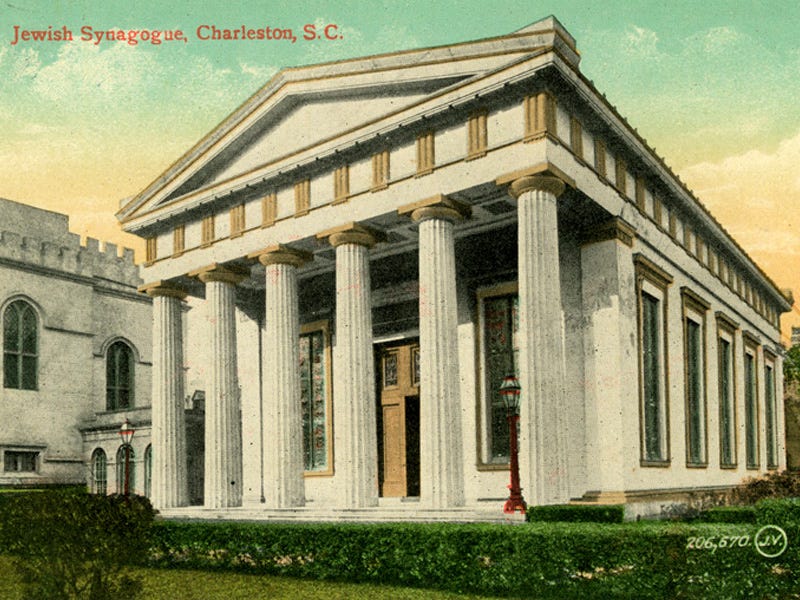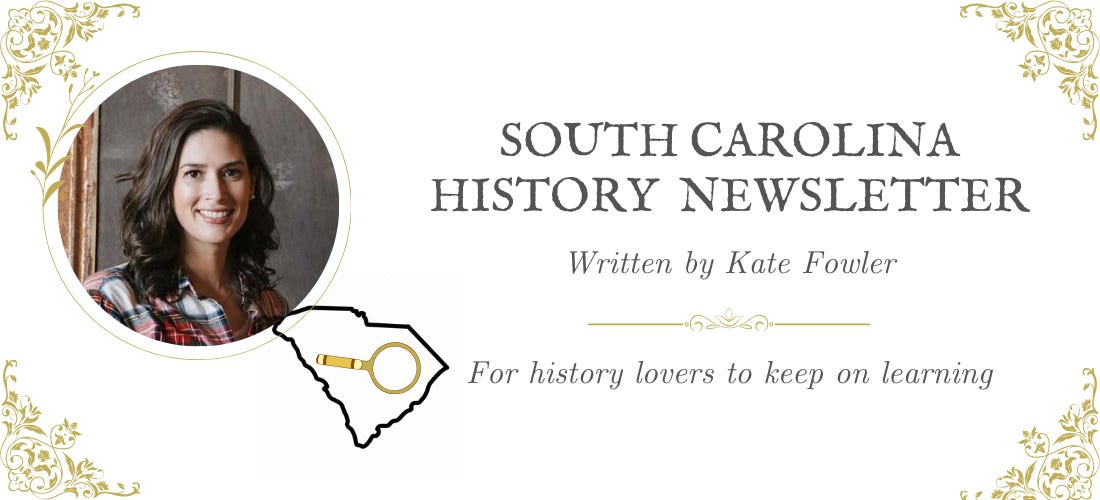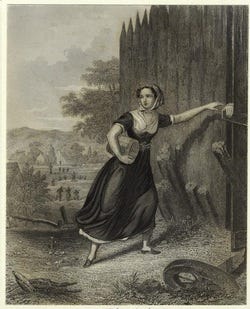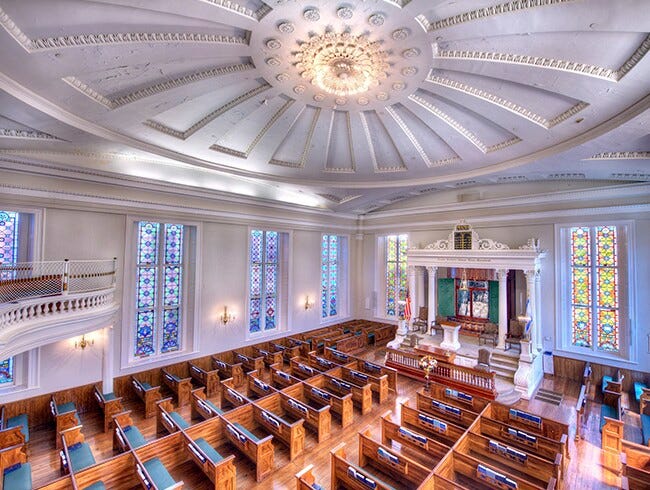#30: The heroine of the Battle of Cowpens, a Jewish patriot, and I want your opinion!
For South Carolina history lovers far and wide! Today I make some important announcements as I continue to improve the SC History Newsletter - with your valuable feedback, dear readers!
Dear reader,
Welcome to Newsletter #30 of The South Carolina History Newsletter! I’m so happy you’re here.
ANNOUNCEMENTS: We are at day #30 of my 100-day writing experiment to build my Substack from the ground up and it’s been an amazing ride so far.
We’ve gone from 0 to 143 free subscribers and 7 paid subscribers, which I am so grateful for!
My dream is to one day make this newsletter my full-time job and your support is helping that dream come true with each passing day — thank you!
In my 100-day writing experiment, I am sending out the SC History Newsletter daily in order to (1) build the content on my Substack and (2) also jumpstart our SC History Newsletter Community. A reminder that after the 100-day writing experiment, the newsletter will become weekly, and I’m cooking up some additional ideas and perks you keep you entertained throughout the week :)
Many of you have given me fantastic feedback about topics you’d like me to write about, and I LOVE any and all feedback — keep it coming!
Every day I think about ways to make the newsletter better, and I also critique my own work as if I was a subscriber myself. Now that we have passed the 30 day mark, I want to make a strategic change to the newsletter and hope you like it. It sounds like many of you find the history section of the newsletter the most valuable. I think the events list in the top part of the newsletter is a bit “bulky” and makes the newsletter very long. The events list is still important to me, as it was one of the original reasons I started the newsletter, as I wanted to hold myself accountable to visit more historical places and connect with other SC history lovers in person. So starting TODAY, Monday, March 11th, the SC History events will be reinvented as a separate weekly email from me. This separate email will list out all the SC history events I have found that are happening statewide for the week ahead, and will provide the link to my full SC History Events Google Calendar.
Also, while I have loved my “3-2-1” format, I’m going to change that up too. Instead of writing “3-2-1” at the beginning of each newsletter, it will now be the # of the newsletter.
I am going to ask for your opinion about these changes on a few parts of the newsletter below — I look forward to hearing your thoughts! Together, we’ll continue to improve the newsletter every week. I want this to be a publication you look forward to and get a lot value from. :)
Meanwhile, the subscriber dashboards is back online! Welcome “gayle.btler” “meghanmlee” “cryan1982” “rickeysnider” “tomfunderburk” “d.e.bradley712” “toddfeaster” “plehman51” “jsirisky” “wreillyiv” “msprojectsme” “ckeese” “allyamoffatt” “scottscottpar” “adamssk5” “andrew.zwanziger” “gdnegrete” “winkatalex” “marthahampshire” “wendysuez” “Jasonblanton88” “glenicewatts” “roxpas” “lisastevens87” “bennett53” “gclawee” to our SC History Newsletter community! Woohoo!
I hope you enjoy today’s newsletter, and as always, please feel free to reply to this email with your ideas and suggestions on South Carolina history you’d like to learn more about. I’m only a click away.
Additionally, please join us & keep the conversation going by becoming a member of our SC History Newsletter Facebook Community here! I can’t wait to meet you.
And now, let’s learn some South Carolina history!
Yours truly,
Kate
(Writing from Greenville, SC)
➳ Upcoming SC History Events
Please click here to visit my SC History Events Calendar that organizes all the upcoming SC history events I have discovered. Please let me know if you’d like to add an event to the calendar! Reply to this email or send me a note at schistorynewsletter@gmail.com.
If you have more detailed feedback, please email me at schistorynewsletter@gmail.com!
➳ SC History Fun Facts
If you have more detailed feedback, please email me at schistorynewsletter@gmail.com!
I.
Do you know why Catherine Moore Berry was named the Heroine of the Battle of Cowpens in 1781?
Catherine Moore Berry (1752-1823) (also known as Kate Barry) was a South Carolina heroine of the American Revolutionary War. She married Andrew Berry in 1767 at the age of 15 and lived on Walnut Grove Plantation in Roebuck, SC. When the Revolutionary War began, Andrew Berry became a “captain and commanding officer in the war” while Catherine became a “spy and messenger” for the American cause.
Catherine was instrumental in warning the South Carolina militia of the incoming British before the historic Battle of Cowpens in 1781. According to local legend, she “tied her toddler to a bedpost” while she rode out on her horse — through Indian trails she knew well — to warn neighbors that the British were coming.
Catherine’s warning prepared the local militia, under the command of Brigadier General Daniel Morgan, to defeat the British troops, under the command of Lord Charles Cornwallis. The Battle of Cowpens was a turning point for the patriot cause, a the SC troops drove the British north and out of the state. During the battle, local legend also has it that Catherine may have joined her husband on the battlefield. While we can’t prove per presence on the battlefield, in the aftermath of the violence, Catherine was called the “Heroine of the Battle of Cowpens,” and received medals for her work as a messenger and spy.
II.
Did you know that up until 1830, Charleston was the unofficial capital of the North American Jewish community in the New World?
(Note from Kate: In preparation for writing this section of the newsletter, I researched the correct words to describe Jewish people and while I was initially hesitant to use the word “Jew,” it is what the Jewish community prefers - see this article here)
The history of Jews in South Carolina centers around their presence in Charleston — starting in the very first days of the colony. The 1669 charter of the Carolina Colony expressly noted “liberty of conscience to all settlers” including “Jews, heathens and dissenters.” Sephardic Jews from London were among the early settlers in the colony. The earliest record of a Jew in Charleston occurred in 1695. The man was as an interpreter for Governor John Archdale and translated between English and Spanish.
By 1702, more Jews arrived in Charleston — again, mostly Sephardic Jews from London and the Netherlands — and they began to vote in local elections. In 1740-41, both Jews and Christians who had settled in Georgia left the colony due to the “illiberal policy of the trustees” and flocked to South Carolina. Charleston continued to be the “preferred destination” of Jewish emigres from London, many of whom were wealthy merchant families. These families became involved in business, trade, finance, and agriculture in Charleston, with some owning plantations.
By 1800, there were “2,000 Jews in South Carolina,” which was the most of any colony, and Charleston remained the “unofficial capital of North American Jewry until about 1830,” when Ashkenazi German Jewish immigrants settled in New Orleans, Richmond, Savannah, Baltimore, and the Northeast (particularly in Boston, New York City, and Philadelphia). The first synagogue established in Charleston was Kahal Kadosh Beth Elohim in 1749.

South Carolina is the first place in America to elect a Jew to public office from 1774-1775. His name was Francis Salvador, and he was the owner of a 7,000 acre plantation in the Ninety Six District. Salvador died fighting for the colonies in the Revolutionary War. See our historical quote below for more (unfortunately gruesome) details of his death.
The Jews of Charleston served valiantly in the Revolutionary War, with many serving as officers. At the outbreak of the American Civil War, the Jews of Charleston “joined their non-Jewish neighbors in the Confederate cause.”
In 1902 Charleston had “fewer than 2,000 Jews,” a population smaller than 86 years earlier in 1816. Today, there are about “11,500 Jews” living in Charleston.
➳ Quote from an SC historical figure
I.
“Here, Mr. Salvador received three wounds; and, fell by my side. . . . I desired [Lieutenant Farar], to take care of Mr. Salvador; but, before he could find him in the dark, the enemy [Cherokee warrior fighting alongside the British] unfortunately got his scalp: which, was the only one taken. . . . He died, about half after two o'clock in the morning: forty-five minutes after he received the wounds, sensible to the last. When I came up to him, after dislodging the enemy, and speaking to him, he asked, whether I had beat the enemy? I told him yes. He said he was glad of it, and shook me by the hand – and bade me farewell – and said, he would die in a few minutes.”
— Colonel William Thomson to William Henry Drayton, in a letter dated 4 August 1776
Sources used in today’s newsletter:
I always want to improve my work. Answer the poll below to give me your review of today’s newsletter. I also welcome your suggestions for new content! Simply reply to this email with your ideas. Thank you!












